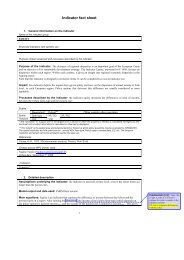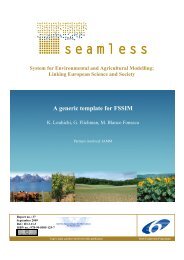Farming Systems Design 2007 - International Environmental ...
Farming Systems Design 2007 - International Environmental ...
Farming Systems Design 2007 - International Environmental ...
Create successful ePaper yourself
Turn your PDF publications into a flip-book with our unique Google optimized e-Paper software.
<strong>Farming</strong> <strong>Systems</strong> <strong>Design</strong> <strong>2007</strong><br />
Field-farm scale design and improvement<br />
the 2 nd and 3 rd year both irrigation and nitrogen exerted a significant effect upon dry biomass (Tab.<br />
1). The reduction of the amount of water supplied (from 75 to 25% of Etc restoration) determined a<br />
yield decrease by 30.4 % in Miscanthus (17.6 t ha -1 vs. 12.2 t ha -1 ), 24.4 % in Arundo (from 28.9 to<br />
21.8 t ha -1 ) and 20.3% in Cynara ( from 24 t ha -1 to 18.7 t ha -1 ), on average of the three years. In<br />
the 4 th year under no-input conditions, Arundo and Miscanthus maintained their productivity level<br />
because of exceptional rainfall occurred during summertime (300 mm). Cynara produced only 6.1 t<br />
ha -1 , being in the decreasing phase of growth (Gherbin et al., 2001).<br />
Table 1 – Net energy yield in studied crops (GJ ha -1 ) from the first to the third year. Values followed by the same letter do<br />
not differ at P ≤ 0.05 by SNK.<br />
Treat. Arundo donax Miscanthus x giganteus Cynara cardunculus<br />
I year II year III year Average I year II year III year Average II year III year Average<br />
I 25 31.8 b 384.5b 556.4a 324.2 -16.5 b 161.8 b 367.5 b 170.9 345.8 a 321.4 b 283.6<br />
I 75 68.4 a 547.9a 633.9a 416.7 -2.4 a 265.7 a 446.0 a 236.4 379.8 a 338.6 a 359.2<br />
N 50 54.3 a 405.1b 549.5b 336.3 -9.7 a 221.2 a 399.1 a 203.5 366.4 a 287.9 a 327.2<br />
N 100 45.9 a 527.3a 640.8a 359.1 -9.2 a 206.3 a 414.4 a 203.8 359.2 a 272.1 a 315.7<br />
Average 50.1 466.2 595.1 370.5 -9.4 213.8 406.7 203.7 362.8 280.0 321.4<br />
In the average of the 2 nd and 3 rd years, the highest net energy yield was recorded in Arundo (530.6<br />
GJ ha -1 ), compared to Miscanthus (340.3 GJ ha -1 ) and Cynara (321.4 GJ ha -1 ) (Tab. 1). The<br />
amount of energy introduced in the system with the increase of irrigation and nitrogen input was<br />
generally lower than that produced with the yield increase. This is generally true with irrigation in all<br />
crops, whereas low irrigation level reduced significantly the net energy yield by 22 % in Arundo and<br />
Cynara and 28% in Miscanthus. As far as nitrogen application is concerned, significant difference<br />
was recorded only in Arundo in the second and third years between N 50 (405.1 and 549.5 GJ ha -1 ,<br />
respectively) and N 100 (527.3 and 640.8 GJ ha -1 , respectively) treatments. The 4 th year Arundo and<br />
Cynara exhibited the highest (552.4 GJ ha -1 ) and the lowest (92.84 GJ ha -1 ) net energy yield,<br />
respectively (Tab. 3).<br />
Table 2 – Energy ratio in the studied crops from the first to the third year. Values followed by the same letter do not differ<br />
at P ≤ 0.05 by SNK.<br />
Treat. Arundo donax Miscanthus x giganteus Cynara cardunculus<br />
I year II year III year Average I year II year III year Average II year III year Average<br />
I 25 1.9 a 17.6 a 24.8 a 14.7 0.6 b 8.1 a 16.8 a 8.5 11.8 a 15.5 b 13.6<br />
I 75 2.2 a 13.4 b 15.1 b 10.2 1.0 a 7.1 a 10.9 b 6.3 8.8 b 23.2 a 16.0<br />
N 50 2.1 a 14.2 a 19.1 a 11.8 0.7 a 8.1 a 14.2 a 7.7 10.8 a 21.4 a 16.1<br />
N 100 1.9 a 16.8 a 20.8 a 13.2 0.8 a 7.0 a 13.5 a 7.1 9.9 a 17.2 a 13.5<br />
Average 2.0 15.5 19.9 12.5 0.8 7.6 13.9 7.4 10.3 19.3 14.8<br />
Energy ratio (output/ input) was the highest in the second and third year in Arundo (15.5 and 19.9<br />
respectively) and in Cynara (10.3 and 19.3 respectively), while was the lowest in Miscanthus (7.6<br />
and 13.9 in the second and third year, respectively). In the fourth year without any input (Tab. 3)<br />
Arundo exhibited the highest energy ratio (73.7) followed by Miscanthus (58.1) and Cynara (13.2).<br />
Table 3 –Net energy yield (b) (GJ ha -1 ) and energy<br />
ratio (c) in the fourth year<br />
Previous<br />
treatments<br />
Arundo donax<br />
L.<br />
Miscanthus<br />
x Giganteus<br />
Cynara<br />
cardunculus<br />
(b) ( c ) (b) ( c ) (b) ( c )<br />
I 25 N 50 538.8 71.9 421.8 56.6 81.8 11.8<br />
I 25 N 100 543.5 72.5 423.9 59.6 90.5 12.9<br />
I 75 N 50 559.7 74.6 466.1 59.4 107.8 15.2<br />
I 75 N 100 567.8 75.7 425.1 56.9 91.3 13.0<br />
Average 552.4 73.7 434.2 58.1 92.8 13.2<br />
Conclusions<br />
The studied crops showed high yield and<br />
energetic levels. Arundo performed better<br />
than the other two crops in terms of yield,<br />
net energy yield and energy ratio, and may<br />
represent a promising crop being endemic<br />
and adapted to the Mediterranean<br />
environment. Cynara moreover may be also<br />
used to the semi-arid environment<br />
conditions, being a winter-autumn crop.<br />
References<br />
Biomass Action Plan of the European Union, 2005.<br />
A. Combes, Elaboration d’un Referentiel pour le Calcule des Bilans Energetic en Agriculture, 1998. Agence de<br />
l'Environnement et de la Maîtrise de l'Energie.<br />
E. P Odum, Basi di ecologia, 1988. Piccin Ed., Padova,<br />
G. Fierotti Carta dei Suoli della Sicilia, 1988. Regione Siciliana Assessorato Territorio e Ambiente, Palermo.<br />
P. Gherbin et al., 2001. Five year evaluation on Cardoon (Cynara cardunculus L. var. altilis) biomass production in a<br />
Mediterranean environment. Italian J. of Agronomy , 5 (1-2): 11-19.<br />
- 42 -




